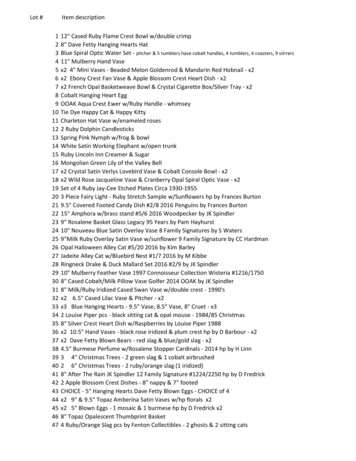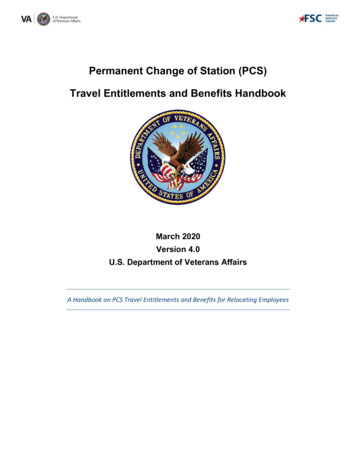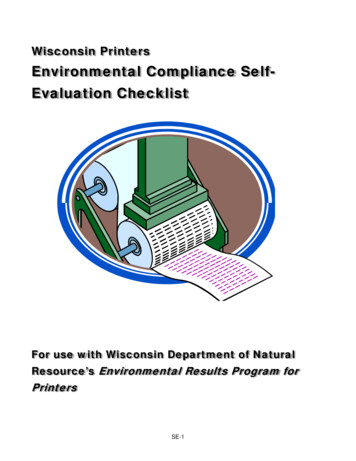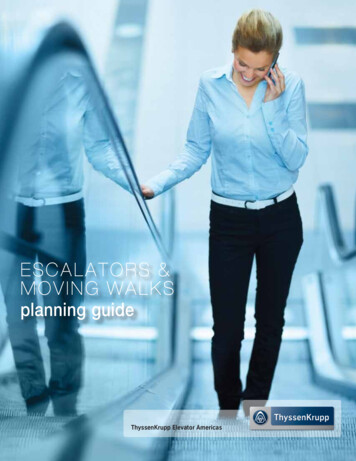
Transcription
Your PCS Guide& Moving Checklist
Table of ContentsShipping Your Car Overseas.16Restrictions .16Permanent Change of Station (PCS): Overview. 4Opening Salvo: PCS Gotchas . 4Five Things to Do When You Get Your PCS Orders. . . 51. Set up a meeting with your base transportation office . . . 52. Contact the family center at your new location . . . 53. If you’re living in government quarters, notify the housing office ofyour projected move date . 5Size Limitations .16Type of POV’s You May Ship .16Leased POV .16When to Ship Your POV .16What You May Leave in Your POV . 17What You May Not Ship in Your POV . 17Tracking Your POV . 17Pet Tips .184. Make an appointment with your finance office at your currentinstallation. . . 5Top 10 Tips for Packing Yourself for a PCS.185. Use the PCS Moving Checklist in this guide . . . 5PCS Responsibilities.19Saving Money for Your PCS. 6At Origin .19What to do now: Avoid Budget Blues . . . 6Upon Arrival .20What to do before you leave: Prevent Moving Mishaps . 7Important Links for Moving Claims .20What to do after you arrive: Fine Tune Your Finances . 7Top 10 Ways to Prepare MilKids for a PCS.21Tips for Valuable Possessions . 7The PCS Move Checklist. 23The Personally Procured Move (PPM) Option. 8Moving ChecklistsAdvantages of the PPM Move . 8Three Months Before Your Move.24Important PPM Notes . 11Two Months Before Your Move.25Top 10 PCS Mistakes. 11One Month Before Your Move.26PCS Weight Allowances.13Three Weeks Before Your Move.27PCS and NTS Weight Allowance (Pounds) .13One Week Before Your Move.28Grade . .13Final Days Before Your Move.29With Dependents . .13The Big Day: Moving Day. 30Without Dependents . .13After Arrival.31Weight Tips .15Other PCS Resources. 3223
Permanent Change of Station (PCS): OverviewFive Things to Do When You Get Your PCS OrdersEveryone in the military is subject to worldwide transfer, based on the needs of the service.Despite this fact, many service members and their families are not clear on what getting PCSorders really entails. Getting a PCS order means moving household goods, shipping vehicles,meeting weight limits, covering airfare and lodging, per diem rates, and on and on.Once you have your PCS orders, in hand, what should your priorities be? Here’s five key steps totake:Unlike other “temporary” travel orders, PCS orders are just as they sound – permanent (well,typically two to four years). Many service members look forward to getting PCS orders, asit can mean a change of scenery, new responsibilities, new missions, and new opportunities.But military families are not always as excited about leaving a familiar community. The thoughtof finding a new home, making new friends, finding new jobs, or starting new schools can beoverwhelming. Keep in mind as you prepare for the big move is thatyour transfer is what you make of it; each new duty station canbring new and exciting opportunities.For most military families, the biggest issue with PCSis the move itself. Packing, housing inspections, househunting, the waiting list for government housing, andtraveling with pets, just to name a few tasks, can makethe process daunting.Understanding your rights, responsibilities, benefits,allowances, and the impact on your pay can helpelevate the anxiety of “getting orders.” Thisguide was designed for that specificreason; to help you understand allthe aspects of military transfers, bytaking the mystery out of the acronyms,providing easy to follow checklists, linksto important resources, and helpful tipsand insights that can help make yourmove a smooth one.Opening Salvo: PCS Gotchas1. Don’t wait for orders first. It is a mistake to wait on official orders before starting toget ready for your move. Go through the moving checklists featured in this guide, and getas many items checked off as you can. A headstart now can save on headaches later.2. Don’t be lax about your inventory. Your possessions are important — don’t sit backand expect that they will be properly organized by movers. Be proactive in labeling andkeeping track of your boxes and shipments, and double-check everything with yourmovers.41. Set up a meeting with your base transportation office.Depending on your service branch, the name of the government office that handles yourrelocation varies: The Department of Defense: Joint Personal Property Shipping Office Air Force: Traffic Management Office Army: Installation Transportation Office Navy and Marine Corps: Personal Property Shipping Office Coast Guard: Household Goods Shipping OfficeYou can access information about your specific installation’s transportation office at theMilitary.com Base Guide.Make sure you make an appointment with your office as early as possible. At your meeting,make sure you find out about all the moving options available to you, including a DITY move, andstart making preliminary arrangements for your move.2. Contact the family center at your new location.Family centers offer relocation assistance programs that provide moving information to you andyour family. Ask questions, and learn about your new community and what it offers.3. If you’re living in government quarters, notify the housing office of yourprojected move date.Make sure you also know all the regulations about cleaning your home before you move out.4. Make an appointment with your finance office at your current installation.Making a move will be a drain on your bank account. The finance office can give you thelowdown on your options, as well as relocation benefits that you’re eligible for.5. Use the PCS Moving Checklist in this guide (page 23).In making preparations for a move, it’s easy to be bogged down with all the details and thingsto do. Stay on top of it all with this handy checklist, which covers everything from packing tosetting up in your new location. These ready-to-print lists will remind you what you need to do.If you plan to do a Personally Procured Move (PPM), see the PPM section in this guide for moreinformation, which will help you during your preparations.5
What to do before you leave: Prevent Moving MishapsTIP: Deducting PCS Costs from Your TaxesIf you are a member of the Armed Forces on active duty and you move because of apermanent change of station, you can deduct your unreimbursed moving expenseson Form 3903. For more guidance and information, see this Military.com article.Saving Money for Your PCSWhen you combine moving costs with the difficulty of uprooting your life every few years,relocations can take a big toll. While some moving hassles are unavoidable, you can ease thefinancial pain of PCSing with a little advance planning:What to do now: Avoid Budget BluesWhether your move is days or weeks away, develop a moving budget in advance to keep yourfinances on track and avoid last-minute costs.1. Find out exactly what the military will cover, and what costs fall on you. You can visit yourfamily center and base transportation office for more information.2. Budget for shipping charges, temporary housing expenses, and start-up fees for utilities.3. Make a list of things you’ll have to buy when you move in and estimate those costs.4. Use this budget to determine how much you should save for your next moveSome moving horror stories result from damaged or lost property. When you PCS, insurancecan mean the difference between disappointment and financial disaster.1. Find out how much of your personal property the government movers will insure. If it’snot enough to provide full protection, a temporary renters insurance policy could be anaffordable way to cover the difference.2. If you’re shipping a vehicle, review your auto insurance policy to find out if movingrelated damages are covered. If they’re not, ask your insurer about purchasing shipmentcoverage.What to do after you arrive: Fine Tune Your FinancesOnce you settle into your new place, consider fine-tuning your finances to make your next moveeasier. The stop-and-go that comes with a PCS — stopping everything and starting over againin a new area — can be a shock to your finances. Military members can find some relief byworking with companies that “move with you” and serve your needs wherever you go.Consider using online banking so you don’t have to worry if there’s a branch bank near yournew home. You can also set up automatic bill payments to make your life easier during futuretransitions.1. Choose an insurance company that offers coverage in all 50 states and abroad, so youdon’t have to change providers with every move.2. Open a separate savings account and contribute enough each month to ease the cashcrunch before your next move.3. Set up automatic transfers for investment accounts to ensure your savings habitswon’t slip.Tips for Valuable Possessions6 Have expensive and valuable items (e.g., artwork, collectibles, heirlooms)appraised. This isn’t paid for by the government, but it’s a wise investment in caseof loss or damage. Hold onto your receipts for more expensive items and keepthem separate from the rest of your shipment. Use a video camera or taking close-up pictures to record the condition of yourfurniture, television, and other expensive and/or valuable items prior to packing andpick-up. This will help if you need to file a Loss/Damage Claim. Do not ship small, extremely valuable items such as stocks, bonds, jewelry, coins/coin collections, and items of great sentimental value such as photo albums. Packthem in your suitcases and hand-carry them, as well as your purchase receipts,pictures, and appraisals.7
The Personally Procured Move (PPM) OptionThe Personally Procured Move (formerly known as the Do-It-Yourself (DITY) move) allows youto be reimbursed by the government for moving your belongings yourself. You’re eligible if youmake a Permanent Change of Station (PCS), Temporary Duty (TDY), or Temporary AdditionalDuty (TAD) move, or separate, retire and move to or from government quarters under orders.The program is voluntary.Advantages of the PPM MoveAt first glance, the PPM Program may seem to be more trouble than it’s worth — after all,you have to take care of your own moving arrangements and expenses, rather than have thegovernment do it for you (for some, keeping track of all the receipts is a major hassle by itself).But if you do a little planning and put forth a bit of effort, doing a PPM move offers significantadvantages over a normal military move. For example: Money, Money, Money. In the PPM Program, you receive a government payment of 95percent of what it would cost the government to move you. In addition, you receive thestandard travel allowances for you and your family. If you end up spending less thanthe 95 percent payment the government provides, you get to keep the rest. This maysound difficult, but if you take advantage of moving company discounts and otherspecial offers, you’ll find that you can make money for yourself. You should especiallyconsider a PPM move if you have a limited amount of items that need shipping or moving— you may be able to take care of all the packing and transport yourself.Time, Time, Time. When you receive orders to move to another area, you’re authorizedpermissive TDY or travel time in order to take care of all your moving arrangements. WithPPM, you’ll receive additional time to handle your move — time that you can use to relaxif you’re efficient about planning your move.Total Control. While it’s nice to do without the headaches of planning a move, manymilitary personnel had less-than-ideal experiences when the government took care oftheir moves. With the PPM program, you’re in control every step of the way, from decidingwhich moving services you want to how much of the actual move you want to handleyourself. Certified loaded weight ticket for each shipment with name, your Social Security numberand signature of weight master Original DD Form 1351-2 — Travel Voucher or Subvoucher (ask your PTO representative ifyou have specific questions about this form) Copy of registration for your boat(s) and/or trailer(s) if applicableOnly after applying for and being authorized for a PPM move can you proceed with the move. Ifyou make a partial PPM move (i.e., only shipping a certain amount of household goods), makesure you work out all the details with your PTO representative. Note that you will not receive fullgovernment payment for your PPM move until after your move.Step 2. Decide on your type of move. Will you be doing this all yourself? Will you have packershelp? Will you have a moving company take care of the actual transport? Nail down thesearrangements as soon as possible.Step 3. Arrange for any rental equipment or moving services you need. You can eitherdo it all yourself, have a professional handle tasks, or some of both. Packing materials can bepurchased from commercial suppliers.Step 4. Confirm your insurance coverage. Make sure you are up to date on your car andaccident insurance. If you use a trailer, check your auto insurance policy to make sure you’recovered. State laws regarding liability for accidents during a PPM move vary, so if you’re involvedin an accident while performing a PPM move, you should contact the legal office at the militaryinstallation nearest the accident site as soon as possible.Step 5. Pick up your operating allowance from your local dispersing office.Step 6. When your vehicle (whether you own it or are renting) is ready, calculate the totalweight of what you are moving. You should weigh your vehicle both fully loaded and unloaded.This is extremely important, as your PPM payment will be based on this weight ticket.To calculate the weight of your shipment, follow this formula: Loaded Weight Your vehicle with a full tank of gas all of your property loaded no drivers or passengers insideIf you’re ready to take advantage of the PPM program make sure you follow each of the steps below:Step 1. Apply for the PPM move by scheduling an appointment with your base Personal PropertyTransportation Office (PTO) — this is your opportunity to ask specific questions about your moveand get the low-down on the PPM program. A PTO representative will provide you with all formsand instructions you need. Foremost among these is the DD Form 2278 (Application for Move andCounseling Checklist). Other forms you may need to fill out or provide include:8 Standard Form 1038 — Advance of Funds Application and Account (for advancedoperating allowance) Certified empty weight ticket for each shipment with name, your Social Security numberand signature of weight master9
Empty Weight Your vehicle with a full tank of gas no drivers or passengers inside Loaded Weight - Empty Weight Net Weight of PropertyEach weight ticket should have the following information: Name, grade, Social Security number Name/location of scales Vehicle/trailer identification Date of weighing Weigh Master’s signature Legible of weightsStep 7. Get receipts for all moving expenses. All costs associated with the move are nottaxable, and will be deducted from the allowance you receive from the move to determine youractual financial profit. Only your profit will be taxed, so be sure to keep track of everything tomaximize your profit. Authorized expenses include: Payment for rental vehicles/trailers Packing materials Moving equipment (including hand trucks and dollies) Gas and oil expenses Highway tolls, weight tickets and any other transportation expense directly related to thePPM moveStep 8. Make your move, and submit your settlement. Once you complete your actual move, youhave 45 days to submit a claim for full payment of your PPM allowance. This should include thefollowing: Empty and loaded weight tickets (two copies of each) DD Form 2278 PPM Move certification (attach all receipts for moving expenses) PPM Move expense sheet Change of Station Orders Advance operating allowance paperwork (if you are renting a truck or trailer) Vehicle/trailer rental contract (if you are renting a truck or trailer)More specific details can be obtained from the Personal Property Transportation office atyour installation.10Important PPM Notes: Your base transportation office must approve a PPM. Without approval yourpayment could be limited or denied. Any actual moving costs that exceed the government cost will be at yourexpense, including overweight costs or expenses not covered. An advance allowance may be permitted to help pay for up-frontcosts. Regulations differ by service branch; check with your base transportationoffice. Some expenses are not authorized. These include tow dolly rental, insurancefees and sales tax. Again, check with your transportation office for specifics. Temporary storage may be available with a PPM. Check with yourtransportation office for more information. Be sure to file any loss or damage claims directly with your commercialmoving company before you file with the government. Claims are usually notpaid unless the loss or damage was due to circumstances beyond your control,such as an accident. Payments more than your actual moving costs may be taxable. Read IRSPublication 521 for more information.Top 10 PCS MistakesCourtesy of SpouseBuzz1. Tackling the do-it-yourself move at the wrong time. We all know there’s a season foreverything — and the same thing goes for moving yourself. Spousebuzz fan Ani said they dida DITY while she was six months pregnant. “Turns out I’m not invincible,” she said. Milinda didhers with two toddlers, one of whom was potty training, which she called “our biggest mistake.”Of course, we know that a DITY can be a great idea sometimes. But like everything else in life,it has its time.2. Putting too much stock in your orders. When the military tells you you’re movingsomewhere and finally issues those orders it certainly seems definite. But we know everythingcan change. That’s a lesson fan Beverly learned the hard way when their orders to Alaska werechanged at the last minute to Fort Campbell, Kentucky AFTER they shipped their vehiclenorth and bought a lot of cold weather gear.3. Not grabbing a hard copy of your medical records. Sure, the clinic says your medicalrecords will follow you to your next duty station. But the time to find they did is not after you’vealready moved five states away. Avoid this one by hand carrying your records and those of yourkids station to station. If only Nancy had known this ahead of time. “Now they won’t send acomplete record to the new doctor’s office HUGE pain to deal with.”11
4. Renting out your home from far, far away. Whether by choice or by need, military familiesoften find themselves with a rental property on their hands. Although buying a home while inthe military is a decision that has many pros and cons, one thing is sure: renting it out later fromacross the country or world is a major pain.5. Going back to work too quickly. Military spouses know that if you have the good fortune offinding a job, you should definitely not turn it down. But jumping back into work too quickly afterher PCS but before really getting her family settled, fan Wendy told us, was her biggest PCSmistake.6. Not knowing where your pets are. Last year we asked some military movers at FortCampbell about what the weirdest thing was that they ever had experienced during a pack-out.The answer? Pets. If people aren’t careful to locate and contain their pets before the packerscome, they can get accidentally boxed away. Once, they said, a family pet cat was tragicallypacked in a box spring. By the time the family realized it was missing, the box spring, mattressand cat were all on a truck to California.PCS Weight AllowancesJoint Federal Travel Regulations (JFTR) sets the maximum Permanent Change of Station(PCS) and Non-Temporary Storage (NTS) weight allowances that you can ship and/or store atgovernment expense, based on your rank and dependency status. Weight allowances do notinclude Professional Books, Papers and Equipment (PBP&E/Pro-Gear) or required medicalequipment.PCS and NTS Weight Allowance (Pounds)Grade (see note 1)With Dependents(see note 2)Without DependentsO-6 to ,0000-3/W-314,50013,0000-2/W-213,50012,5008. Forgetting to empty the trash before pack out. The rumors are true, folks, as Lisa learned.If you don’t empty it first, the movers will pack your trash can with whatever is in it. Gross!0-1/W-1/Service AcademyGraduates12,00010,0009. Putting too much faith in your movers. Several fans told us of times they put too much faithin the movers’ ability to not break or hurt their furniture or valuables. And I’ve received furnitureoff the moving truck that is so broken it can’t even stand. But it wasn’t until we moved ourselvesacross town last year that I realized how difficult it is to move things without breaking them. It’sa marvel the professionals break as little as they do as evidenced by the giant, self-inflictedscratches on our table. The best policy? If you really don’t want something scratched or broken,don’t own it or leave at your parents’ house for safe keeping.E-915,000 (see note 3)13,000 (see note 3)E-814,00012,000E-713,00011,000E-611,0008,00010. Not doing enough research. Cody said she wishes they had looked for reviews ontheir future landlord. “Just because you found them on AHRN.com doesn’t make them goodbusinesspeople or good people in general!” she said.E-59,0007,000E-48,0007,000E-1 to E-38,0005,000Aviation Cadets8,0007,0007. Letting the movers take the furniture parts. Jessie told us something many of us havelearned the hard way — if all of your furniture parts go into a box and that box is the one thatdisappears, you’re in big trouble. “Finding new hardware for a desk and bed is a pain,” she said.“Lesson learned.” She said she wishes they had taped the pieces to the furniture they belongedto. Our advice? Move the parts yourself so you know they won’t go missing or fall off the placethey are taped.Service Academy Cadets/Midshipmen1235013
Note 1: Includes a Uniformed Service regular and Reserve Component member, and an officerholding a temporary commission in the US Army/Air Force. Also includes a member appointedfrom an: Enlisted/warrant officer grade to a commissioned officer grade, or Enlisted grade to a warrant officer grade or rating is authorized the grade’s weightallowance: oHeld on the member’s PCS authorization/order effective date used for HHGtransportation, oroFrom which an appointment was accepted, whichever is greater.Upon reversion, the member is authorized the weight allowance of the grade held:ooOn the member’s PCS authorization/order effective date then being used for HHGtransportation, orWeight Tips: You are responsible for staying within your weight allowance. Get an earlystart on estimating the weight of your household goods (HHG), before you visityour Transportation Office, which will require an estimated weight for eachshipment you intend to make. Weight estimates are not official. They are planning tools only. You can neveruse weight estimates to refute excess weight charges. Excess Weight Big Costs. Exceeding your authorized weight allowance ona move can end up with you getting overcharged several hundred to severalthousand dollars. Contact your local transportation officer for additionalinformation regarding excess costs. If you’re moving overseas Some overseas areas impose administrative weightrestrictions. If the area to which you are assigned provides government furniture,for example, you may get a weight restriction, which would prevent you fromshipping your full weight allowance overseas. If you are administratively weightrestricted, you have the option of storing the remainder of your HHG in long termstorage (NTS), or you may ship your HHG to a designated location within theContinental US (CONUS) for the duration of your overseas tour. Be sure to checkwith your transportation office about your options. Know before you go. If you are transporting a vehicle, PPM moves require you toweigh the vehicle empty and loaded before departing and once again upon arrivalat your destination. Weigh stations that issue official certified weight tickets canbe hard to find; make sure you know exactly where to take your vehicle beforeyou leave your old duty station, otherwise you may have to delay unloading yourhousehold goods when you get to your new home. See the “Shipping Your CarOverseas” section for more vehicle transport tips.Before reversion, whichever is greater.Note 2: For this table, a member “with dependents” is a member who has a dependent eligibleto travel at government expense incident to the member’s PCS. Actual dependent travel has nobearing. Incident to a member’s first PCS after: The death(s) of all of the member’s dependent(s), or A divorce that leaves the member with no dependent(s) eligible to travel at governmentexpense, the member has the weight allowance of a member “with dependents”.Note 3: A member selected as Senior Enlisted Advisor to the Chairman of the Joint Chiefs ofStaff, Sergeant Major of the Army, Chief Master Sergeant of the Air Force, Master Chief PettyOfficer of the Navy, Sergeant Major of the Marine Corps, or Master Chief Petty Officer of theCoast Guard is authorized a weight allowance of: 17,000 pounds withdependents or 14,000 poundswithout dependentsfor a PCS authorization/order issued on orafter receiving noticeof selection to thatposition and for theremainder of themilitary career.1415
Shipping Your Car OverseasWhat You May Leave in Your POVIf you receive PCS orders that require international relocation, you’re entitled to ship yourprivately owned vehicle (POV) from or between locations overseas. If you wish to ship your POVoverseas it must be authorized on your orders. Alternate ports may be used if approved by themilitary traffic management command (MTMC). Requests to use an alternate port shouldbe addressed your installation’s Personal Property Shipping Office (PPSO), which you can findthrough the Military.com Base Guide.Only authorized personal articles may remain in your POV when it’s turned in for processing. Allhousehold items and camping equipment must be removed. You may ship the following:RestrictionsYour owned or leased POV may be shipped to your new duty station at the government’sexpense. If you want to make your own arrangements to ship your own POV, consult yoursponsor and transportation office for any restrictions. You may have to pay an import duty on asecond POV. Your local transportation office has information on the host country’s restrictions.Size LimitationsThe government will pay for the shipment of a POV that does not exceed 20 measurement tons.A compact car averages 9 tons and a full-size car is about 15 tons. Measurement tons can bedetermined by multiplying the length (in feet) by the height by the width, and then dividing by 40.Here’s the formula: L in feet x H in feet x W in feet Tot
6 7 TIP: Deducting PCS Costs from Your Taxes If you are a member of the Armed Forces on active duty and you move because of a permanent chang










